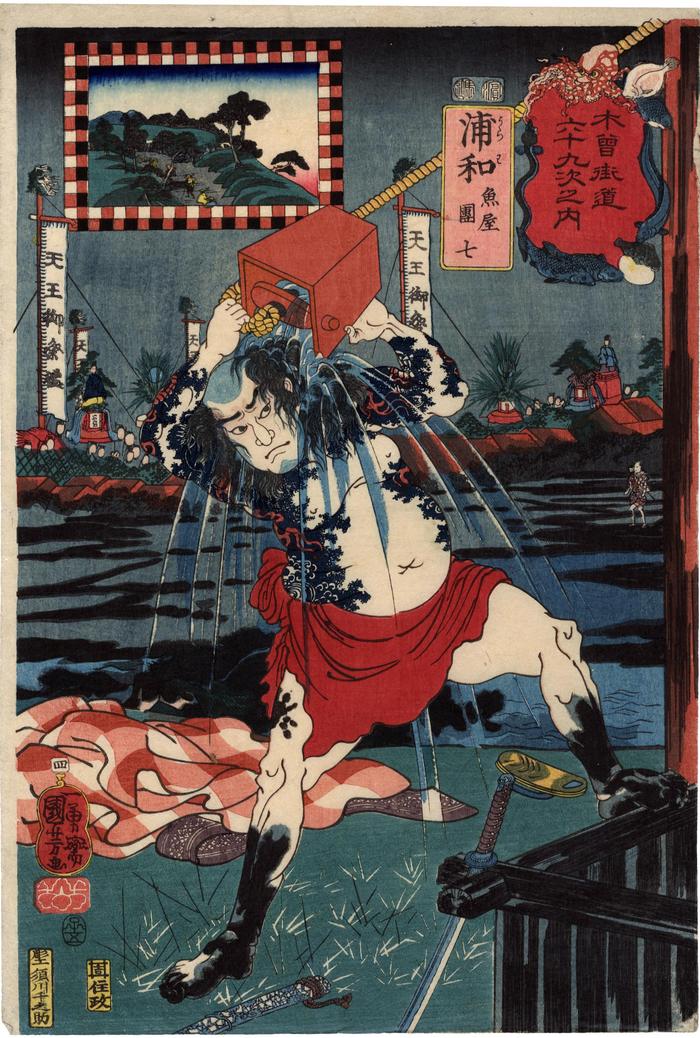Utagawa Kuniyoshi (歌川国芳) (artist 11/15/1797 – 03/05/1861)
No. 4 (四) Urawa (浦和):The fishmonger Danshichi (魚屋團七) from the series Sixty-nine Stations of the Kisokaidō Road (Kisokaidō rokujūkyū tsugi no uchi - 木曾街道六十九次之内)
05/1852
10 in x 14.75 in (Overall dimensions) Japanese color woodblock print
Signed: Ichiyūsai Kuniyoshi ga
一勇斎国芳画
Artist's seal: kiri
Publisher: Sumiyoshya Masagorō
(Marks 498 - seal 21-062)
Carver's seal: Hori Sennosuke
彫工須川千之助
Date: 5/1852 .
Censor: Hama & Magome
British Museum
Honolulu Museum of Art
Tokyo Metropolitan Library
The Agency for Cultural Affairs
Museum of Fine Arts, Boston
Hiroshige Museum of Art
Google maps - Urawa can be found at Saitama - enlarge the map
Musée Cernuschi
Allen Memorial Art Museum, Oberlin College
National Museum of Asian Art "The kabuki play Summer Festival in Osaka (Natsu matsuri Naniwa kagami) was based on a real-life incident of 1744, when a fishseller killed another man in a brawl. A fictionalized version of the incident was presented as a puppet play in Osaka in 1745, and a kabuki version debuted in Kyoto just a month later. Both performances were tremendous hits because of their innovative staging: the climactic murder scene took place in real mud, which was then washed off using real water, creating a pleasant feeling of coolness for audiences at this summer play.
The fishseller Danshichi - whose occupation is indicated by the fish decorating the series border - is hot-tempered but good-hearted. He and his Tokubei have sworn to help Isonojo, the son of Danshichi's former employer, and Isonojo's lover, Kotoura, a former courtesan who is being stalked by a lecherous samurai. Unfortunately, their kindness is undermined by Danshichi's greedy old father-in-law, Giheji. Matters come to a head one hot summer night when Giheji tries to kidnap Kotoura and sell her to the man who is stalking her. Danshichi rescues the girl and sends her home, and then argues with his father-in-law. The quarrel escalates into violence, and Danshichi finally kills Giheiji. Then, as the Kozu Shrine festival parade takes place in the background, he washes the mud and blood from his impressively tattooed body and joins the festival crowd to make his escape.
Danshichi's distinctive red-checked kimono lies on the ground, and the same pattern forms a frame for the inset landscape. The title of this scene from Summer Festival in Osaka is "A Back Street in Nagamachi" ("Nagamachi ura"); the word for "back street" (ura sounds like the first part of the name Urawa."
Quoted from: Utagawa Kuniyoshi: The Sixty-nine Stations of the Kisokaidō by Sarah E. Thompson, p. 24.
****
The banners in the background if for the Tennō Festival and reads 天王御祭禮.
****
A fishmonger is a sakayana (魚屋). The series title cartouche in this print is surrounded by the tools of the trade, i.e., fish, that Danschichi would sell. We can identify a few, but not all, of them: an octopus, a flounder, an eel, a blowfish, et al.
****
Illustrated:
1) in a full-page color reproduction in Utagawa Kuniyoshi: the Sixty-nine Stations of the Kisokaidō by Sarah E. Thompson, Pomegranate Communications, Inc., 2009, page 25, no. 4.
2) in color in Heroes and Ghosts: Japanese Prints by Kuniyoshi 1797-1861 by Robert Schaap, Hotei Publishing, 1998, page 105, no. 91. "Urawa is the fourth station on the Kisokaidō." Robert Schaap wrote: "The station of Urawa, depicted in the inset panel at he top left, is associated with the otokodate ('street-knight') and fishmonger, Uoya Danshichi Kurobei. Kurobei is shown cleaning off mud and blood with a bucket of water after killing his father-in-law in the paddy fields."
3) in a small black and white reproduction in Japanese Woodblock Prints: A Catalogue of the Mary A. Ainsworth Collection, by Roger Keyes, 1984, page 190, #491.
4) in color in Utagawa Kuniyoshi: 342 Color Paintings [sic] of Utagawa Kuniyoshi by Jacek Michalak, Kindle Edition, 2022, unpaginated.
Danshichi Kurobei (団七九郎兵衛) (role)
landscape prints (fūkeiga 風景画) (genre)
Sumiyoshiya Masagorō (住吉屋政吾郎) (publisher)
Tattoo (genre)
